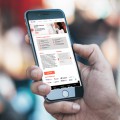Three Questions Enterprises Should Ask About iOS 8
— September 19, 2014“iOS 8 is the biggest release for developers since the introduction of the App Store.”
Apple’s iOS 8 release marked a pivotal point in the evolution of enterprise mobile development, introducing new tools and capabilities that redefined what mobile applications could accomplish. According to Apple’s developer homepage, iOS 8 isn’t just an operating system upgrade—it’s a platform transformation. This release focuses on workflow integration, seamless data-sharing, and empowering developers to create sophisticated user experiences. For enterprises involved in mobile application development, understanding the nuances of iOS 8 is critical. The implications are vast, influencing everything from user privacy to data security and the future of app-based workflows.
In this article, we’ll break down the major ways iOS 8 reshapes enterprise app development, focusing on three central questions every CIO should be asking: how to handle privacy in the age of HealthKit, how to secure fluid data, and whether biometrics are truly ready for enterprise use.
1. Handling Privacy in a HealthKit-Enabled World
When Apple introduced HealthKit and HomeKit with iOS 8, they opened doors to a new realm of possibilities in health and home automation. HealthKit, for example, enables users to manage and share personal health data between compatible apps and devices, making it easier to track fitness metrics, health indicators, and even life-critical information such as blood pressure and glucose levels. Similarly, HomeKit allows users to control various home automation devices, integrating these controls within the iOS ecosystem.
For the average user, these are exciting developments. But for enterprises, particularly those with BYOD (Bring Your Own Device) policies, these updates come with significant privacy considerations. As employees use personal apps that leverage HealthKit on corporate devices, companies face a unique dilemma: balancing privacy with security.
The implications go beyond the individual; in some cases, corporate policies that do not account for HealthKit’s capabilities could lead to dangerous outcomes. For instance, if an employee uses a HealthKit-enabled app to monitor blood pressure or manage diabetes, wiping data on the device could inadvertently put the person’s wellbeing at risk. This concern underscores the importance of defining privacy policies that address life-critical scenarios and safeguard both personal and corporate data.
#Recommendation
CIOs and IT managers should revisit privacy policies, making sure they account for mixed-use devices. Adopting a model that allows for selective management and selective wiping—where only enterprise-related data is removed without affecting personal information—will help secure enterprise data while respecting user privacy. Companies must also clearly communicate these policies to employees, highlighting how both their personal and professional information will be protected under corporate guidelines.
2. Securing Fluid Data in a New Era of Workflow-Based Apps
Traditionally, mobile apps were often siloed experiences, with strict boundaries around data access and sharing. iOS 8 dismantles many of these barriers through features like Handoff, app extensions, and improved cloud integration. These advancements allow data to flow seamlessly across applications and devices, following the user rather than confining them to a specific device or app.
The introduction of Handoff, for instance, enables users to begin a task on one Apple device and continue it on another, such as starting an email on an iPhone and finishing it on a Mac. App extensions further allow apps to offer functionality in contexts outside the primary app interface, making it possible to embed useful tools within other apps. While these are powerful tools for enhancing user experience, they also introduce risks around data security.
For enterprise app developers, this flexibility enables the creation of workflow-based applications that move data fluidly across tasks, which can significantly increase productivity. A salesperson, for instance, could easily move from a client interaction on an iPhone to updating records on an iPad without interruptions. However, without appropriate safeguards, corporate data could inadvertently be exposed to unauthorized devices or applications.
#Recommendation
To mitigate the risk of data leakage, enterprises should establish clear app design and data-sharing guidelines. These should address the specific features of iOS 8 that enable data fluidity, such as Handoff and app extensions, ensuring that developers understand the security protocols. Additionally, companies may consider app containerization—a practice that isolates corporate data within a secure ‘container’ on the device—to limit unauthorized access while still enabling seamless workflow functionality for end users.
3. Evaluating the Readiness of Biometrics for Enterprise Security
Apple’s introduction of Touch ID in the iPhone 5s in 2013 paved the way for a new wave of biometric authentication. Touch ID allowed users to unlock their devices or make iTunes purchases with a simple fingerprint scan, bypassing the need to enter a password. With iOS 8, Apple expanded the functionality of Touch ID, giving third-party developers access to this biometric technology for the first time.
This change presents an enormous opportunity for enterprises to simplify authentication processes while strengthening security. Imagine a corporate app that requires a fingerprint scan instead of a lengthy password—this could reduce the friction employees experience when accessing sensitive data on mobile devices, while enhancing security. Additionally, biometrics reduce the threat of compromised devices, as unauthorized users would need more than a password to access the device’s contents.
However, introducing biometrics into enterprise applications requires a measured approach. While Touch ID is user-friendly, it’s not infallible. Issues around fingerprint spoofing and device sharing can still arise. Enterprises considering biometrics must weigh the convenience against the risks and ensure that biometric data is managed in compliance with privacy regulations.
#Recommendation
Enterprises should pilot biometric authentication in select applications to test its effectiveness and usability in real-world scenarios. Define clear use cases for biometrics within your broader security strategy, and ensure that biometric data is securely stored and managed. Apple’s biometric API provides robust security features, but companies should develop policies that explicitly address when and how biometric authentication will be used to prevent unauthorized access to sensitive information.
The Shift to Phase III of Mobile Enterprise Computing
The evolution of mobile enterprise computing can be divided into three distinct phases:
1. Phase I: Wireless email, which dominated enterprise mobility for nearly a decade.
2. Phase II: The rise of standalone apps, which helped organizations view mobile devices as serious business tools rather than merely communication devices.
3. Phase III: Workflow-based applications, ushered in by iOS 8, which transforms mobile devices into integral parts of the business workflow, enabling genuine business transformation.
This third phase, marked by Apple’s forward-thinking approach to workflow integration, sets the stage for a new era of enterprise computing. With iOS 8, mobile devices are no longer merely endpoints for communication and basic productivity tasks. Instead, they are dynamic tools that integrate with various parts of the organization’s workflow, allowing data to flow seamlessly across applications and devices. The impact on productivity, user experience, and organizational agility is profound.
Implications for Enterprises: Moving Forward with Agility and Security
iOS 8’s new capabilities will likely spark fresh waves of innovation across sectors. For example, companies involved in healthcare, finance, and software outsourcing (such as those in Vietnam’s booming tech scene) stand to benefit from the platform’s enhanced data-sharing and workflow capabilities. However, adapting to these changes requires a strategic approach, as organizations must tackle new challenges around privacy, app design, and security.
#Practical Steps for Enterprises
1. Update Security Policies and IT Infrastructure: Ensure your IT policies reflect the changes brought by iOS 8, especially in areas like data-sharing and privacy. Updating infrastructure to support these policies is essential for smooth adoption.
2. Train Developers on New iOS 8 Features: Offer workshops and resources to educate developers about iOS 8’s new capabilities and how to use them securely. This will enable them to build apps that align with your organization’s goals and security requirements.
3. Encourage Cross-Departmental Collaboration: Work closely with departments such as HR, legal, and compliance to develop holistic policies that address both user experience and corporate security.
4. Monitor and Evaluate Impact: Implement a system for tracking how iOS 8’s new features are impacting productivity, security, and user satisfaction. This data will help you refine your approach over time, ensuring that your organization stays competitive.
Conclusion
As mobile devices become ever more entwined with daily work processes, the strategic role of mobile OS updates cannot be underestimated. iOS 8 represents a foundational shift in mobile enterprise computing, moving organizations closer to fully integrated, workflow-based environments. By addressing key issues like privacy in a HealthKit world, securing fluid data, and adopting biometric authentication thoughtfully, enterprises can harness the power of iOS 8 to drive innovation and agility.
Keeping up with the rapid changes in mobile technology may be challenging, but it’s a challenge worth undertaking. Companies that proactively adapt to iOS 8’s capabilities will not only enhance their operational efficiency but also improve user experience, laying the groundwork for a truly mobile-first future.







